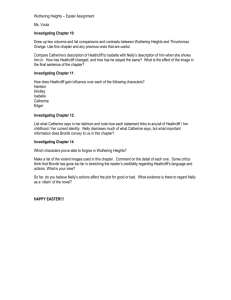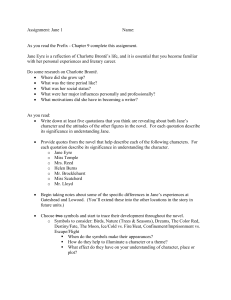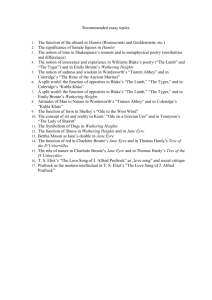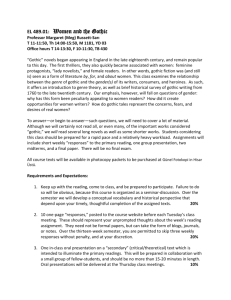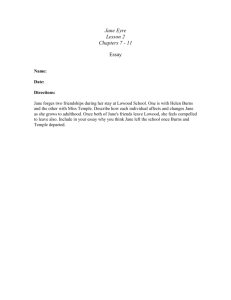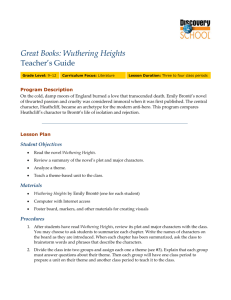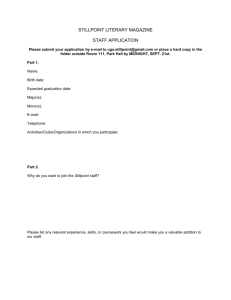Lecture 11- The Early Victorians 1
advertisement
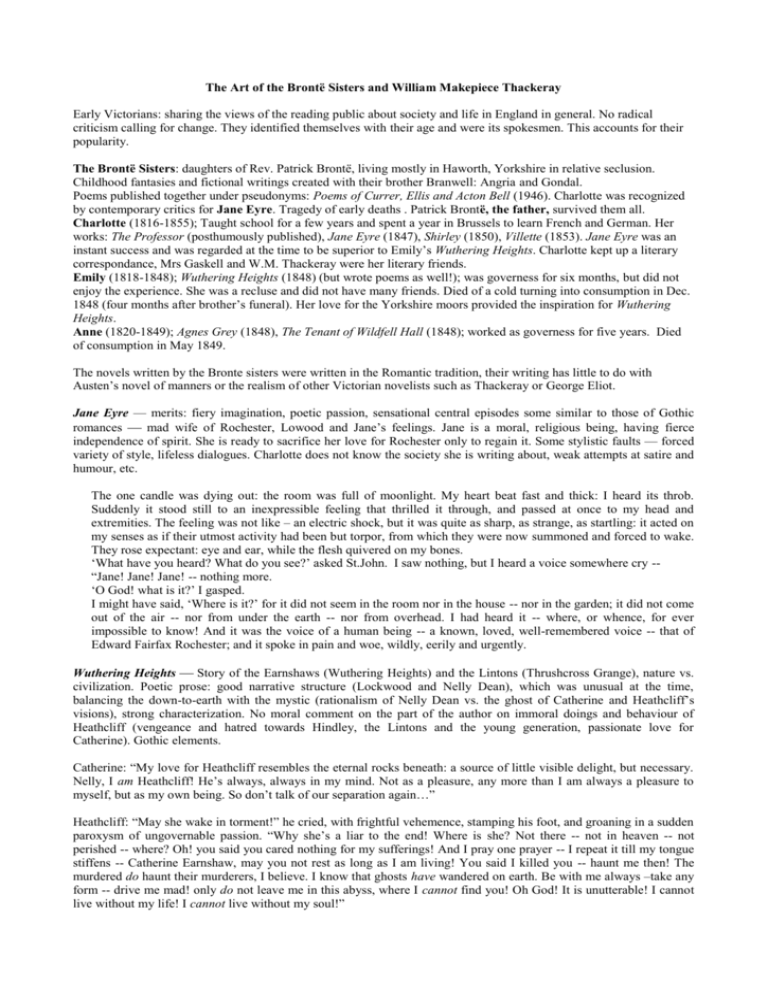
The Art of the Brontë Sisters and William Makepiece Thackeray Early Victorians: sharing the views of the reading public about society and life in England in general. No radical criticism calling for change. They identified themselves with their age and were its spokesmen. This accounts for their popularity. The Brontë Sisters: daughters of Rev. Patrick Brontë, living mostly in Haworth, Yorkshire in relative seclusion. Childhood fantasies and fictional writings created with their brother Branwell: Angria and Gondal. Poems published together under pseudonyms: Poems of Currer, Ellis and Acton Bell (1946). Charlotte was recognized by contemporary critics for Jane Eyre. Tragedy of early deaths . Patrick Brontë, the father, survived them all. Charlotte (1816-1855); Taught school for a few years and spent a year in Brussels to learn French and German. Her works: The Professor (posthumously published), Jane Eyre (1847), Shirley (1850), Villette (1853). Jane Eyre was an instant success and was regarded at the time to be superior to Emily’s Wuthering Heights. Charlotte kept up a literary correspondance, Mrs Gaskell and W.M. Thackeray were her literary friends. Emily (1818-1848); Wuthering Heights (1848) (but wrote poems as well!); was governess for six months, but did not enjoy the experience. She was a recluse and did not have many friends. Died of a cold turning into consumption in Dec. 1848 (four months after brother’s funeral). Her love for the Yorkshire moors provided the inspiration for Wuthering Heights. Anne (1820-1849); Agnes Grey (1848), The Tenant of Wildfell Hall (1848); worked as governess for five years. Died of consumption in May 1849. The novels written by the Bronte sisters were written in the Romantic tradition, their writing has little to do with Austen’s novel of manners or the realism of other Victorian novelists such as Thackeray or George Eliot. Jane Eyre — merits: fiery imagination, poetic passion, sensational central episodes some similar to those of Gothic romances mad wife of Rochester, Lowood and Jane’s feelings. Jane is a moral, religious being, having fierce independence of spirit. She is ready to sacrifice her love for Rochester only to regain it. Some stylistic faults — forced variety of style, lifeless dialogues. Charlotte does not know the society she is writing about, weak attempts at satire and humour, etc. The one candle was dying out: the room was full of moonlight. My heart beat fast and thick: I heard its throb. Suddenly it stood still to an inexpressible feeling that thrilled it through, and passed at once to my head and extremities. The feeling was not like – an electric shock, but it was quite as sharp, as strange, as startling: it acted on my senses as if their utmost activity had been but torpor, from which they were now summoned and forced to wake. They rose expectant: eye and ear, while the flesh quivered on my bones. ‘What have you heard? What do you see?’ asked St.John. I saw nothing, but I heard a voice somewhere cry -“Jane! Jane! Jane! -- nothing more. ‘O God! what is it?’ I gasped. I might have said, ‘Where is it?’ for it did not seem in the room nor in the house -- nor in the garden; it did not come out of the air -- nor from under the earth -- nor from overhead. I had heard it -- where, or whence, for ever impossible to know! And it was the voice of a human being -- a known, loved, well-remembered voice -- that of Edward Fairfax Rochester; and it spoke in pain and woe, wildly, eerily and urgently. Wuthering Heights Story of the Earnshaws (Wuthering Heights) and the Lintons (Thrushcross Grange), nature vs. civilization. Poetic prose: good narrative structure (Lockwood and Nelly Dean), which was unusual at the time, balancing the down-to-earth with the mystic (rationalism of Nelly Dean vs. the ghost of Catherine and Heathcliff’s visions), strong characterization. No moral comment on the part of the author on immoral doings and behaviour of Heathcliff (vengeance and hatred towards Hindley, the Lintons and the young generation, passionate love for Catherine). Gothic elements. Catherine: “My love for Heathcliff resembles the eternal rocks beneath: a source of little visible delight, but necessary. Nelly, I am Heathcliff! He’s always, always in my mind. Not as a pleasure, any more than I am always a pleasure to myself, but as my own being. So don’t talk of our separation again…” Heathcliff: “May she wake in torment!” he cried, with frightful vehemence, stamping his foot, and groaning in a sudden paroxysm of ungovernable passion. “Why she’s a liar to the end! Where is she? Not there -- not in heaven -- not perished -- where? Oh! you said you cared nothing for my sufferings! And I pray one prayer -- I repeat it till my tongue stiffens -- Catherine Earnshaw, may you not rest as long as I am living! You said I killed you -- haunt me then! The murdered do haunt their murderers, I believe. I know that ghosts have wandered on earth. Be with me always –take any form -- drive me mad! only do not leave me in this abyss, where I cannot find you! Oh God! It is unutterable! I cannot live without my life! I cannot live without my soul!” The Tenant of Wildfell Hall - outright depiction of drunkenness and debauchery (model: brother Branwell?). Warning readers of where such behaviour can lead. William Makepeace Thackeray (1811-1863) Born in Calcutta, India. Sent to England at the age of five. Studied at Trinity College, Cambridge. Began his career as a journalist contributing to Fraser’s Magazine and Punch. To Punch he contributed The Snob Papers, which were collected into The Book of Snobs. A snob is someone who is imitating a social superior, who “meanly admires mean things.” He saw himself writing in the realistic tradition; interested in society, which seems to be characterized by hypocrisy and opportunism. The Paris Sketch Book (1840) The Irish Sketch Book (1843) Notes of a Journey from Cornhill to Grand Cairo (1846) Vanity Fair (1847) Pendennis (1849-1850) The History of Henry Esmond, Esquire (1852) The Newcomes(1855) The Virginians(1857-1859) Vanity Fair- A Novel without a Hero — a satire of contemporary English society although the story is set in time one generation earlier than the time of Thackeray. Title alludes to Vanity town in Bunyan’s Pilgrim’s Progress (1678). Merits: Creation of characters who are so alive, they seem to live outside the pages of the book: e.g. Becky Sharp. Attractive, immoral, but not completely wicked. Uses eighteenth century techniques (Fielding) of talking to the reader, making digressions. The reader is not expected to sympathize with any of the characters. There is an omniscient narrator, but reader sees things from a double angle: the narrator’s and from the point of view of the “puppet” characters. There is a tendency in the book to associate cleverness with evil and goodness with foolishness.
